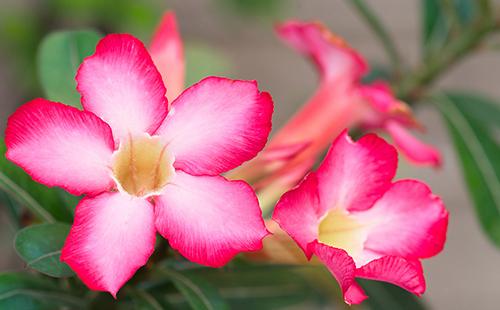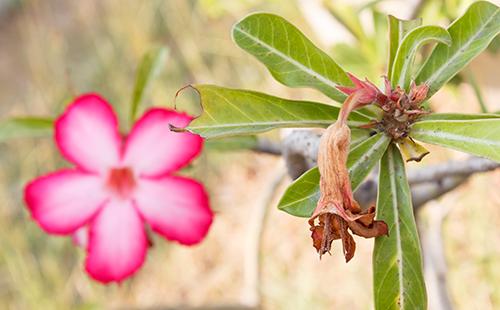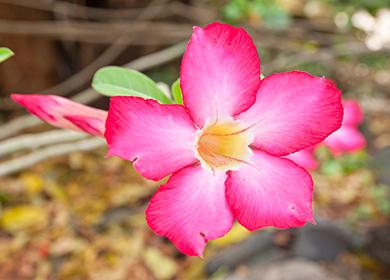The content of the article
The genus of adeniums includes several varieties of succulents of a shrub or tree type. All of them are valued for decorative olive-oil leaves and large beautiful flowers.
Appearance and decorative qualities
Deciduous succulent, belongs to the family Sutra. In the wild grows in Thailand, Africa and Malaysia, reach a height of three meters. Potted varieties do not grow above 60 cm.
A striking feature of adenium is pronounced caudex (thickening in the lower part of the trunk). The bark on the stems is smooth, grayish in color. Hue can vary from grayish to greenish depending on the variety and lighting. Caudex begins underground, but most of it is on the surface. The superficial roots are voluminous, curiously curved.
Thin branching shoots with beautiful glossy leaves grow in the upper part of the caudex. The shape of the leaves is often oval, the edges are smooth, the tip is pointed. Leaflets slightly bent along the middle vein.
Adenium blooms in the second or third year of life. The first flowering is sparse with single buds. As you grow older flowers become more and more. The buds are large, five-petalled, bright pink. The center of the flower is lighter than the edges. It blooms for several months. Under good conditions, it can bloom year-round.
The most interesting varieties
In total, there are about seven species of adenium. Four interesting, very decorative views deserve special attention.
- Fat Adenium. Most common as a potted plant. It differs in very large flowers, long flowering. Flowers in bright pink or red colors. It blooms from late spring.
- Arab adenium. The appearance of the Arabian adenium maximally copies the wild species. Short succulent with bright pink flowers. It blooms only in spring. It differs by a pronounced dormant period, sometimes partially drops leaves.
- Socotran adenium. Dwarf variety. A distinctive feature is the increased decorativeness of the leaves. Leaflets are green with a silver or blue tint. Flowers are bright red or delicate pink.
- Somali Adenium. Among decorative adeniums is considered the largest variety. It blooms early - in the second year of life. The small size of the flowers is offset almost year-round flowering.
General content rules
The difficulty of growing adenium is medium. It easily adapts to any conditions, lends itself well to shaping. Beginners are advised to read the general rules for caring for adenium.
- Lighting. Very photophilous plant. It can grow on the south window without shading. They shade with tulle only on the hottest days. Move away from the glass - there is a possibility of getting burns. After a winter holiday, the sun is taught gradually.
- Temperature. In summer, adenium is kept at 25-30 ° C. He tolerates heat well. It can be exposed outside, providing protection from rainfall. They are kept cool in winter, but cooling is not allowed below 10 ° C. It is highly recommended not to supercool the roots - this is one of the common causes of plant death.
- Watering. In summer you need to water regularly, but only after the soil has completely dried. In winter, the frequency of watering depends on the temperature of the content. At 15-20 ° C they are watered as the soil dries. At lower temperatures, you can do without watering. In the spring, watering is resumed gently, about two weeks after the awakening of the buds.
- Humidity. The meaty caudex contains enough moisture - an artificial increase in air humidity is not required. Responds to spraying gratefully. During flowering, they are sprayed gently, avoiding droplets falling on the buds.
- Top dressing. It grows well in poor soils, but adenium can be fed once a month. Use fertilizers for succulents. Concentration is minimal - no more than 2%.
- The soil. The composition of the soil for young plants must include coarse sand. It is mixed with an equal amount of turf and a little crushed coal is added. In the substrate for adult specimens, the amount of turf is increased, but the composition is “diluted” with brick chips. Be sure to provide a good layer of drainage.
- Transfer. Young specimens are transplanted annually. To transplant an adult adenium into another pot, you need good reason. The transfer rules will be discussed in detail below.
Care for adenium at different periods
Features of care depend on the condition, growth phase of adenium. In winter and summer, different conditions of detention are required.
After the purchase
How to care for adenium after purchase? The flower needs to be helped to adapt, get used to new conditions of detention.
- Adaptation. If you bought a flower in the cold season, then do not bring it immediately into the heat. Leave in a cooler place for a couple of hours. For example, in the corridor. Try to avoid too sharp temperature differences.
- Quarantine. For ten days, set the flower apart from the rest of the plants. This will give time to identify pests, and the flower - to adapt to the new environment. During quarantine, do not water or feed the adenium.
- Transfer. After quarantine, transplant the flower into a suitable container and soil. Leave for a couple of days in gentle conditions. Only after this can a beginner be placed in the rest of the plants.
During flowering
How to care for adenium during flowering? With the advent of the first buds, they carefully monitor the condition of the flower. Some tips to keep blooming longer.
- Temperature. Keep the flower in a well-lit room with moderate temperature. The heat during this period leads to the rapid decay of flowers. If it is not possible to create a favorable temperature regime, spray the caudex daily, avoiding moisture getting on the flowers.
- Peace. Try without unnecessary need not to disturb the flower - most plants are sensitive to unnecessary movements during flowering.
- Moisture. Avoid prolonged drought.Wait for the soil to dry, but water regularly.
- Drafts. Avoid drafts and sudden temperature changes. Adenium can respond to them by dropping buds.
In winter
In late November or early December, adenium begins to gradually sink into a state of winter dormancy. This is due to a reduction in daylight hours. Under natural conditions, at this time, the flower receives limited moisture - it spends its reserves. To bloom adenium in the spring, they try to create similar conditions at home.
Many do not water adenium in winter. But there are supporters of the restriction, not the cessation of watering. Their frequency will depend on the temperature of the content.
- At 12-15 ° C. The rest period is long. Watering is moderate, once a month.
- Above 15 ° C. Water more often, as the soil dries. The duration of winter dormancy is reduced.
Transplant Rules
Adenium belongs to those cultures for which every detail is important to maintain decorativeness. Adenium loves peace, so it is transplanted only in extreme cases.
Reason for changing the pot
Young plants are transplanted often - annually or even twice a year. For adult specimens, completely different rules. Mature adenium is transplanted in the following cases.
- Small pot. The roots of adenium are very powerful and developed. When they run out of space, the pot bursts.
- Rot of root or caudex. The only way to save the adenium is to cut the rotted areas and transplant.
- Poor soil. If you got an adenium with suspicious soil, salt or mold deposits formed on the substrate, it is better not to risk the plant's health - transplant it.
- Big pot. Adenium bought or donated in an oversized pot is also better to transplant. In a large volume of land, flowering will slow down, the normal cycle of plant development will be disrupted.
General recommendations
The sequence of operations during transplantation is usual. The flower is removed from the pot, freed from the old earthen mixture, planted in a more spacious pot, fresh soil. But there are several important nuances.
- Watering. Water the adenium a couple of days before the transplant. After drying the land, transplant. Watering of adult adenium resumes only after a week, actively growing - after three to four days.
- Root damage. If you accidentally damage the roots of adenium, sprinkle the wounds with carbon powder. Dry the plant for two days before planting - the wounds should dry.
- Caudex Formation. Each time during a young adenium transplant, lower the landing line by a couple of centimeters. Part of the root system will remain at the top - over time, a full-fledged caudex will form.
- Soil moisture. Adenium is transplanted into the soil of moderate humidity. In dry soil, the flower will take root longer, moist will condense over time.
How to instill
An interesting technique is the adenium vaccine. The procedure helps to increase decorativeness - flowers of different shades will bloom on one plant. For example, fully developed branches of other varieties are inoculated on a healthy adult adenium. It is better to take the graft with plentifully blooming, healthy flowers. It is best to vaccinate in the spring, during the period of active sap flow. You can use one of two methods.
- In the cleavage. The rootstock trunk (the base for grafting) is cut vertically in the middle to a depth of about 10 cm. The grafting branches (which are grafted) are wedge-shaped, cut into the cut and wrapped tightly with electrical tape.
- Oblique cut. The stock and scion are cut at the same angle so that they can be tightly combined. It is well fixed, wrapped with electrical tape. You can use a special gel for vaccinations.

Why does not bloom, and how to make
Despite the full care, adenium sometimes does not bloom. What could be the reason? How to make adenium bloom?
The reasons
The main reason is inappropriate conditions of detention, care errors. Flowering becomes sparse or stops completely in the following cases.
- Excess fertilizer. With frequent dressing, the plant begins to fatten. It grows rapidly, starts up new shoots, leaves become large and beautiful, but flowering does not occur.
- Spacious pot. Excess space gives about the same effect - adenium actively grows roots, green mass, but does not bloom.
- Lack of light. Light is needed for laying flower buds.
- Root problem. Affordable watering in cold weather - the roots rot.
- Lack of rest period. Cool winter content is the main condition for flowering.
How to stimulate
Adenium grown from seeds blooms in the second to fourth year of life. Flowering time depends on the variety. For flowering, three basic conditions must be met:
- Winter peace.
- Full coverage.
- Timely pruning.
Pruning stimulates the growth of new shoots, contributes to the abundant laying of buds. Adenium trimming begin at a young age. The best time for pruning is spring. In young specimens growing in one trunk, the growth point is cut off. After some time, the sleeping kidneys will awaken, new shoots will go. Flower buds will form on them. In adult adeniums, lateral shoots are cut for further branching.
Breeding methods
The best time for any method of reproduction is spring. Use vegetative and seed propagation.
Seed cultivation
Description. Growing adenium from seeds at home is considered the best way to propagate. Sowing seeds begin in late February.
Procedure
- Before sowing, it is recommended to soak them for half an hour in water with the addition of potassium permanganate or treat with fungicide. Subsequent soaking for five hours is needed for faster seed germination.
- A loose mixture of vermiculite, sand and ground coal is used as a substrate.
- Seeds are distributed on the surface, sprinkled on top with the same substrate.
- Maintain a high temperature - 32-35 ° C. Good, fresh seeds germinate within a week. When cool, seeds can rot.
- With the advent of the first sprouts, a container with seedlings is placed under phytolamps. It can be replaced by a fluorescent lamp.
- Do not allow cooling below 18 ° C.
- In the phase of two true leaves, seedlings are gradually transferred to the classic regime of care.
- At the stage of the second pair of leaves, they can be planted in separate containers.
Rooting apical cuttings
Description. A more complicated way - the cuttings often rot. To properly root the adenium, you need to adhere to a certain scheme.
Procedure
- Cuttings are cut up to 15 cm.Places of cuts are powdered with coal powder.
- Rooted only in light mixtures - mix sand and charcoal or use perlite. Around the base of the cuttings are placed coal chips or clean, calcined sand.
- Create good lighting, heat in the range of 25-30 ° C. The substrate is watered very moderately.
Air lay
Description. The method is rarely practiced due to complexity. To obtain layering perform the following procedure.
Procedure
- Choose a strong, thick shoot (about 2 cm). Perform on it a shallow incision in a circle.
- Dry for an hour, sphagnum dipped in a solution of the root stimulant.
- In the incision area, moistened sphagnum is attached, covered with a piece of polyethylene, and fixed well.
- Periodically, the moss is moistened.
- With the advent of the roots, the branch is cut off and placed in the ground.
Disease
Almost all adenium diseases are associated with a violation of the irrigation regime. Excessive waterlogging leads to decay. More detailed information about diseases and their treatment is given in the table.
Table - Adenium Diseases
| Disease | The reasons | Manifestations | Treatment |
|---|---|---|---|
| Grafted Adenium Root Rot | - Low temperature and high humidity | - yellowing of the leaves; - withering of the plant; - softness of caudex | - Rinsing the roots; - removal of rot; - Coating the roots with gruel from ampicillin; - drying of roots; - treatment of the aerial parts with the drug "Fundazol"; - planting in a dry substrate |
| Seedling root rot | - Abrupt cooling of the wet root system | - yellowing of the leaves; - softness of caudex | - Rinsing the roots; - pruning rot; - drying and planting; - if the root system rotted, rooting of the remaining cuttings |
| Viral spotting | - virus | - Curved, spotty leaves | - not treated |

Growing difficulties
Loss of decorativeness, yellowing, falling leaves are not always associated with diseases. More often, the reason lies in improper care. The table describes the most common difficulties in growing adenium. Problems are solved by adjusting care.
Table - Problems of growing adenium
| Problem | Possible reasons |
|---|---|
| Crooked leaves | - Uneven watering, alternation of drying and bays |
| The tips of the leaves are dry | - Too dry air; - not enough moisture; - a sharp change in conditions of detention; - excess sun |
| Small leaves | - Frequent drying of the soil; - dense soil; - lack of nitrogen |
| Leaves turn yellow | - problems with the roots; - lack or excess of moisture |
| Leaf lethargy | - stuffy room; - excess moisture |
| Adenium leaves fall | - The onset of the rest period; - low temperature and damp soil |
| Brown spots | - Sunburn |
| Slow growth | - Lack of nutrition; - little light at rest |
| Fast withering colors | - heat; - low humidity |
| Reddish shade of foliage | - Lack of copper |
Common pests
Pests attack the adenium infrequently, but there is always the risk of insect damage. The pests most often encountered are described in the table.
Table - Adenium Pests
| Insect | Signs of defeat | Way to fight |
|---|---|---|
| Root worm | - stunting; - faded leaves; - yellowing of the leaves; - the leaves are wrinkled | - Three-time soil treatment with “Aktara”, “Confidor” preparations; - washing the roots in very warm water |
| Mealybug | - Wax, cotton-like coating; - sugary secretions | - Treatment with soapy water; - spraying with drugs "Aktara", "Fitoverm" |
| Spider mite | - Fading of leaves; - yellow dots on the leaves; - barely noticeable cobweb | - Spraying means "Floramayt", "Masay"; - increase in air humidity |
In the reviews, experienced flower growers write that a single treatment of adenium with chemical preparations is not enough. Even if externally no pests are detected, after a week, it is necessary to re-process.
Since you need to take care of the adenium carefully, this flower is not too suitable for busy people and beginner gardeners. When growing adenium, you must strictly adhere to the rules of care, to have at least basic formation experience.

